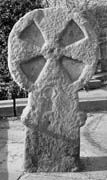Select a site alphabetically from the choices shown in the box below. Alternatively, browse sculptural examples using the Forward/Back buttons.
Chapters for this volume, along with copies of original in-text images, are available here.
Object type: Cross-head and -shaft [1]
Measurements: H. 109 cm (43 in); W. of head 58 cm (23 in); of shaft 39 > 32 cm (15.5 > 12.5 in); D. 22 cm (8.5 in)
Stone type: Light grey (N7), poorly sorted, clast-supported, quartz sandstone. The sub-angular to sub-rounded clasts range from fine-grained (0.2 mm) to very coarse-grained (2.0 mm), but are mostly medium- to coarse-grained in the range 0.4 to 1.0 mm. Millstone Grit, Carboniferous
Plate numbers in printed volume: Ills. 723-6
Corpus volume reference: Vol 9 p. 262-3
(There may be more views or larger images available for this item. Click on the thumbnail image to view.)
Ring-headed cross of type E6 but with flat central disc (the latter clear on face A but uncertain on face C); the spandrels are unpierced. The narrow edges of the shaft carry two horizontal roll mouldings, one set on top of the other, 5 cm (2 in) deep.
A (broad): There are traces at the top of the stone that the ring and arms were distinguished from each other by an incised groove; the arms carried a shallow border. The only decoration otherwise visible on the head is a drilled hole in the central flat disc. Overlying the lower arm and ring is the rounded head of a pair of incised shears whose arms extend into the shaft; this is placed off-centre to the left. No other decoration survives on the shaft apart from rounded dogtooth or chevron mouldings on the lower right edge.
B and D (narrow): No decoration apart from the double moulding on the shaft
C (broad): As face A but without any clear disc at the centre of the arms; incised lines distinguishing ring and arms are clearer on this face. Dogtooth or chevron moulding is faintly visible on the lower left corner of the shaft.
Appendix A item (stones dating from Saxo-Norman overlap period or of uncertain date)
This shaft has a superficial resemblance to a series of Cornish crosses which also have 'earless' ring-heads with unpierced spandrels and, crucially, projections on the shaft (Langdon 1896, 155–70). The extensions here, however, are set further down the shaft than on the examples from the south-west, and the more telling parallel is with the Norman cross at Stanground, Huntingdonshire which has a similar form of head and projections on the shaft (Brown, G. 1937, pl. XXXI). Though Baldwin Brown argued for a pre-Conquest context for this latter cross, it seems more likely to be of twelfth-century date (Everson and Stocker 1999, 90). The Foulridge cross should be assigned to the same period: the form of the projection is not one used elsewhere in pre-Conquest work and, although dogtooth mouldings were used within the region at a late pre-Conquest date (see Anderton 1 and Whalley 3), the shears are a familiar symbol on twelfth- and thirteenth-century grave-slabs (Ryder 1985, 21–4; Butler 1987).



